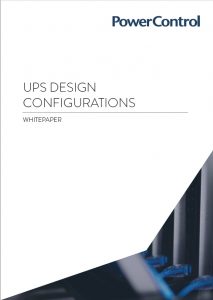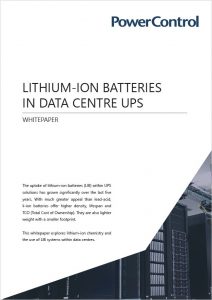White Papers - Covering both technical and non-technical insights
These informative papers have been written by members of our very own Power Control team
Capturing the essence of preventative maintenance
Thermal imaging records the concentration of radiation in the infrared part of the electromagnetic spectrum and converts in into a visible image. Today, thermal imaging is often the first choice in preventative maintenance and is one of the most non-intrusive, non –invasive and non-destructive diagnostic tools for predictive maintenance of a UPS.
Advanced battery testing
A large and rapidly growing mass of lead acid batteries are providing critical backup power to data centres, banks, hospitals, telecom sites and many large commercial and industrial installations. It is essential that these batteries remain in superior condition at all times.
Lithium-ion batteries, An alternative to VRLA
The principle difference between li-ion batteries and VRLA batteries is the chemical makeup of molecules in the electrodes (anode and cathode) and of the electrolytes. This paper compares the batteries and explains the different performance capabilities of each.
Capacitors and fans within UPS systems
When capacitors are proactively changed when recommended, it protects the UPS system against major failure and reduces the risk of unplanned downtime. Maximised performance can be achieved with careful planning by replacing these components towards the end of their rated service life or just before.
UPS design configurations
Uninterruptible power supplies (UPS) are installed for mitigating risks to critical infrastructure, this is often achieved by scaling the number of UPS systems in a configuration to cope with the; load requirement, budget, existing infrastructure and risk tolerance. This whitepaper explores the five principle UPS arrangements, explaining the suitable applications and advantages and limitations of each.
HTM compliance regarding primary, secondary and tertiary power supplies
HTM 06-01 focuses on the supply and distribution of electrical services, highlighting the importance of reducing the probability of equipment failure during a primary mains power outage through secondary and tertiary power backup systems. Although the meeting all the points set out in the HTM is not a legal requirement, it does form the foundation of statutory law and so every effort should be made to comply. This whitepaper provides an overview of tertiary power supplies within a healthcare environment and provides a breakdown of components discussing how to ensure they comply with the HTM.
Lithium-ion batteries in data centre UPS
The uptake of lithium-ion batteries (LIB) within UPS solutions has grown significantly over the last five years. With much greater appeal than lead-acid, li-ion batteries offer higher density, lifespan and TCO (Total Cost of Ownership). They are also lighter weight with a smaller footprint. This whitepaper explores lithium-ion chemistry and the use of LIB systems within data centres.

 DOWNLOAD NOW
DOWNLOAD NOW




